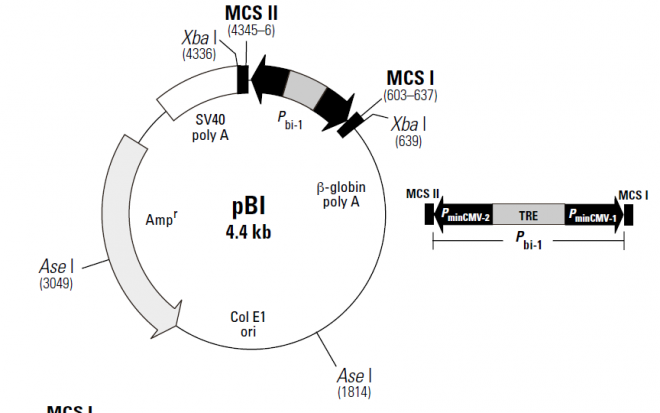pBI Tet 载体
| 质粒类型: | 四环素调控系统 |
|---|---|
| 载体大小: | 4.4kb |
| 载体抗性: | Ampicillin (氨苄青霉素) |
The pBI Tet Vector is a response plasmid that can be used to express two genes of interest from one bidirectional tet-responsive promoter (Pbi-1; 1) in Clontech’s Tet-On® and Tet-Off® Gene Expression Systems and Cell Lines (2). The Tet Expression Systems and Cell Lines give researchers ready access to the tetracycline-regulated expression systems described by Gossen & Bujard (3; Tet-Off) and Gossen et al. (4; Tet-On). The pBI Tet Vector contains the bidirectional promoter Pbi-1 which is responsive to the tTA and rtTA regulatory proteins in the Tet-Off and Tet-On systems, respectively. Pbi-1 contains the Tet-responsive element (TRE), which consists of seven copies of the 42-bp tet operator sequence (tetO). The TRE element is between two minimal CMV promoters (PminCMV), which lack the enhancer that is part of the complete CMV promoter. Consequently, Pbi-1 is silent in the absence of binding of TetR or rTetR to the tetO sequences. PminCMV-1 and PminCMV-2 control the expression of two separate genes of interest. Note that the cloned inserts must have an initiation codon. In some cases, addition of a Kozak consensus ribosome binding site (5) may improve expression levels; however, many cDNAs have been efficiently expressed in Tet systems without the addition of a Kozak sequence.
载体应用
pBI allows the simultaneous regulation of two genes of interest by one central TRE. After a stable Tet-On or Tet-Off cell line has been established by transfecting with a tTA or rtTA regulator plasmid, pBI is cotransfected with pTK-Hyg (Cat No. 631750) to permit selection of a double-stable cell line which expresses both genes of interest. Alternatively, pPUR (Cat No. 631601) or another selection plasmid can be used. If this plasmid contains an enhancer element, as does pPUR, cointegration of pBI and the selection plasmid may lead to higher background expression. Double-stable, tet-responsive cell lines with pBI response constructs can be developed using the protocols described for pTRE response plasmids in the Tet Systems User Manual (PT3001-1).


